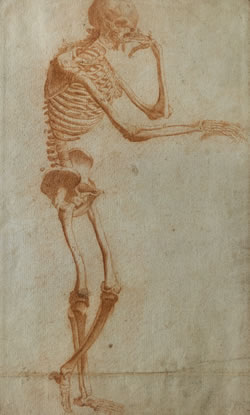This article is part of the series "A Moment in History" where we honor those who have contributed to the growth of medical knowledge in the areas of anatomy, medicine, surgery, and medical research.
The following article was written by my good friend Pascale Pollier-Green and it recounts the long road that has taken her and other Vesaliana followers all over the world, and has resulted in the publication of the book "In the Shadow of Vesalius". Dr. Miranda
The concept behind the book “In the shadow of Vesalius” is probably best described by the opening address of the editor and one of the authors, Professor Robrecht Van Hee. Following here are a few excerpts from his transcript:

Pascale Pollier-Green, author of this article
“The quincentenary of Vesalius’s birthday in 2014 has been characterized by a flow of colloquia and publications on the Flemish anatomist, often presenting new insights concerning his life and death, as well as concerning his works and iconography.
This revival of interest has subsisted and induced new symposia and initiatives, resulting in new congress proceedings and publications, reflecting the search of an increasing number of scholars into the anatomical, social, and artistic influences of Vesalius and his opus magnum book "De Humani Corporis Fabrica Libri Septem" on 16th century and later scientific evolution.”
This book focuses on some of these anatomists, artists, publishers and other personalities, who in different ways remained in the shadow’ of Vesalius.
This is most pertinent in the case of Vesalius’s collaborator and artist Jan Steven van Calcar, whom Vesalius only mentioned as ‘his friend’, but was probably responsible for at least an important number of the plates and figures in the famous Fabrica and Epitome. This gradually gains momentum enhanced by a recently found drawing (figure 1) which is commented on in the book by Caiati and co-workers, and is believed to be a preliminary sketch by Jan Steven van Calcar of one of the most iconic drawings in the Fabrica, namely the so-called ‘Philosopher’. (see image)
It is in this light that I would like to take a few people out of the shadows and bring them into the spotlight, and by this, explaining how this book came about.
Click on the image for a larger version
I first was introduced to Bob Van Hee in 2006 by Ann Van de Velde. Professor Robrecht H. Van Hee who is a surgeon and medical historian, with over 160 publications to his name, has always had a special interest in Andreas Vesalius. In 2005 he promoted Vesalius for a television contest programme about “Who’s the most famous Belgian in history”.
In 2007 Ann and I were organizing the AEIMS conference “Confronting Mortality with Art and Science”. This conference brought together a group of artists, scientists and medical illustrators.
Bob van Hee and anatomist Francis Van Glabbeek both gave excellent lectures on Vesalius, Triverius and Philip Verheyen during a nocturnal visit to the Plantin Moretus museum in Antwerp.
It was also at this conference I invited Joanna Ebenstein to give a talk on her then new project” The morbid anatomy library blog” which has grown into the amazing art /science platform it is today.
The conference was such a success that we decided to set up BIOMAB, Biological and Medical Art in Belgium, with a teaching programme ARSIC ( art researches science international collaborations) .
BIOMAB would never have seen the light of day if it wasn’t for the energy, and drive and fearless enterprising spirit of hematologist and medical artist; Dr. Ann Van de Velde. Over the years we have organized many dissection drawing workshops, exhibitions, conferences, made films and books and have written many articles and given many lectures. Our article in the book “Anatomical Drawing From Cadavers – Limb by Limb Removed -- Brought Us Together” elucidates our collaborations and our intension and achievements.
Anatomist and surgeon Professor Francis Van Glabbeek, founding member and currently President of BIOMAB, and a passionate collector of antiquarian medical books, has been a driving force in continuing Vesalius’s legacy by bringing artists together with scientists, and, in the spirit of Vesalius, teaching anatomy from direct observation. I remember the first meeting with Francis with much fondness. He lovingly showed me a first edition of the Fabrica and spoke with so much passion and knowledge about the work and influence that Vesalius and the Fabrica still have on anatomy today.
This article continues HERE




